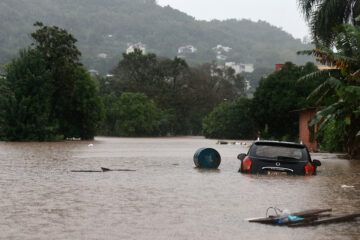Nord Stream Nr. 2: The Project’s Implications in Europe
By Vladimir Socor
Russia, Germany and a consortium of Western European companies have re-activated the Gazprom-led Nord Stream Two gas pipeline project. Parallel to the existing Nord Stream One pipeline on the Baltic seabed, Nord Stream Two would double the system’s total capacity to 110 billion cubic meters (bcm) annually, all earmarked for direct delivery to Germany.
Nord Stream is billed as the world’s biggest natural gas transportation project, in terms of pipeline length and throughput capacities. Initially announced in 2011–2012 through non-binding agreements of intent, Nord Stream Two had to be shelved for the duration of Europe’s economic slump. The project agreement signed on September 4, 2015, however, is binding. Gazprom’s management anticipates economic-financial recovery in Western Europe and, consequently, gas demand recovery by 2019, the target date for completing Nord Stream Two. It also expects gas extraction to decline in Norway after having been capped in the Netherlands, thus boosting European import demand (Gazprom.com, accessed September 14).
The project’s other role is to bypass Ukraine’s gas transit system, its continuation through the Slovakian and Czech transit corridors, and potentially Poland’s. Those transit routes are beyond Gazprom’s control. The Kremlin intends to re-direct the lion’s share of its gas exports to the “old” European Union into the Gazprom-controlled Nord Stream route. This would not merely deprive Ukraine and those other countries of transit revenue. Strategically, it would result in Gazprom controlling gas transportation as well as the supply to Western European customers.
Gazprom claims that it would, in due course, deliver “new gas”—i.e., gas sourced from newly developed fields—through Nord Stream. But it has not identified those resources; its barely disguised near-term intent is to switch the flow from Ukrainian pipelines into Nord Stream. For years to come, gas volumes diverted from Ukraine will be Nord Stream’s main resource.
In the short and medium term, Nord Stream Two strengthens Russia’s hand against Ukraine and a number of Central-Eastern European countries. Gazprom will henceforth be able to bypass or cut off these countries—or extort concessions under such threats—before these countries would have made arrangements with non-Russian suppliers.
As a bypass project, Nord Stream Two is potentially more effective compared with South Stream (in its various configurations). Bypassing Ukraine, South Stream would have changed Gazprom’s export route but would have targeted basically the same markets. Nord Stream Two, however, aims to break into new, highly lucrative markets in northwestern and western Europe. Or by words of prof. Anis Bajrektarevic: “This arching pipeline network eliminates any transit barganing premium from Eastern Europeans and poses in effect a joint Russo-German pressure on the Baltic states, Poland, Ukraine, and even as far as to Azerbaijan and Georgia.”
The European Commission finally blocked South Stream on the legal level at the end of 2014; and the other southern bypass option, Turkish Stream, looks no more convincing in 2015, even to Moscow, than its closely resembling predecessor Blue Stream Two had looked a decade ago. Thus, Moscow has turned to Nord Stream again in the new circumstances and based on its forecasts of medium-term market demand (see above).
If completed as designed, Nord Stream Two could cement the Russo-German special partnership in the energy sector for the long term, with ramifications in the financial sector and foreign policy.
Germany is the exclusive designated recipient of Nord Stream gas. This evolution casts Germany in a new role, on top of Germany’s familiar role as Europe’s leading importer of Russian gas. Nord Stream Two promises the much-coveted status of an “energy hub” for Germany. It opens the prospect for Germany to become the main center for the transit and storage of Russian gas and its onward distribution in Western Europe. This would mean higher sales revenues for German energy companies, as well as a potential windfall from transit fees and taxes accruing to the German federal and state budgets. Even if Nord Stream One and Two operate (as seems likely) below their combined capacity of 110 bcm per year, the volumes carried into Germany could be staggering in magnitude. The prospects of transit and tax revenue on such a scale must be a significant consideration behind the German government’s support for Nord Stream Two.
Designating Germany as the privileged “hub” country is not an entirely novel idea in Moscow. In 2006, President Vladimir Putin had publicly offered to select Germany as the distribution center for Russian gas in Western Europe. Counting at that time on the development of Russia’s supergiant Shtokman field, Putin proposed to export Shtokman gas through the then-planned Nord Stream One pipeline to Germany, for onward distribution to other EU countries. The Shtokman project, however, turned out to be unfeasible and was abandoned in 2012.
Putin’s stillborn offer to Germany in 2006 would not have affected the Ukrainian transit of Russian gas to the European Union, given that Shtokman gas would have been “new gas,” not diverted from the Ukrainian transit system. Now, however, Russia is at war in Ukraine and is enlisting Germany into this anti-Ukrainian project. It can also be viewed as an anti-EU project, insofar as it enables Gazprom to replace a transportation route beyond its control with a route under its control.
Part Two
Within Germany, Nord Stream has spawned a system of gas transmission pipelines and storage sites, dedicated to handling Gazprom’s gas en route to German and other countries’ markets. That system’s ownership and operation pose serious challenges to the European Union’s energy market and competition norms. Those challenges will mount, if and when Nord Stream Two adds another 55 billion cubic meters (bcm) to Nord Stream One’s 55 bcm in annual capacity. From 2012 to date, Nord Stream One has operated at about half-capacity.
The dedicated infrastructure on German territory includes the OPAL and NEL transmission pipelines and the Rehden and Jemgum storage sites, all intended to operate in conjunction with Nord Stream One and Two. Gazprom and other Nord Stream stakeholders in various combinations also own and operate OPAL, NEL, Rehden and Jemgum. Alongside that dedicated system, Gazprom and Wintershall jointly operate another gas transmission network that can also be fed with gas volumes from Nord Stream One and Two.
The European Commission had, all along, viewed those plans as aiming to create vertically integrated monopolies. The Commission used its authority and legal powers to resist such arrangements (e.g., restricting Gazprom’s use of OPAL to one half of that pipeline’s capacity). For their part, the German government and regulatory agencies allowed Gazprom to expand its pipeline and storage assets in Germany through joint ventures with German companies. A flurry of such takeovers were agreed upon in 2013 and early 2014, linked with the completion of Nord Stream One and the expected agreement to build Nord Stream Two. Russia’s military intervention against Ukraine in February 2014, however, made it politically impossible for Germany to complete those transactions.
Germany’s time-out is now over. On September 4, Gazprom’s buyout of Wintershall’s gas trading and storage was finalized, and the Nord Stream Two shareholders’ agreement was signed. The agreement has created the New European Pipeline AG project company to build and operate Nord Stream Two. The companies’ press releases stopped short of identifying the chief executive of the New European Pipeline AG project company. Gazprom’s photo of the signing ceremony, however, shows an uncaptioned Matthias Warnig signing the Nord Stream Two agreement, alongside the presidents/CEOs of the stakeholder companies (Gazprom.com, accessed September 14). As managing director of Nord Stream One since that project’s inception, Warnig will apparently hold the same position in Nord Stream Two. Nord Stream Two’s shareholding largely overlaps with that of Nord Stream One and with the shareholdings of the dedicated onshore pipelines and storages in Germany.
These actions are already accompanied by pressures from the interested companies and the German government to override EU energy market and competition legislation. German Finance Minister Wolfgang Schaeuble apparently proposes transferring some of the European Commission’s anti-trust competencies to other authorities, not publicly specified as yet. Germany’s own anti-trust and regulatory agency, the Bundesnetzagentur, does not object to Gazprom’s monopolistic use of the OPAL and (in prospect) NEL pipelines (Naturalgaseurope.com, September 3).
According to the European Commission, the offshore Nord Stream One was implemented in line with EU law at that time, but “the Commission will ensure that Nord Stream Two, if implemented, fully complies with the EU’s Third Package of energy legislation.” And “any pipelines, whether northern or southern, on EU member countries’ territories must be fully compliant with EU legislation (Bloomberg, UNIAN, September 11). This official statement alludes, first, to the fact that the Third Package was not yet in force when Nord Stream One was built, but has entered into force since then. It further alludes to the European Commission’s effective use of EU law to block South Stream—that other Gazprom-led project in Europe.
The European Commission’s vice-president for the Energy Union, Maros Sefcovic, has announced “a host” of questions to be raised on Nord Stream; e.g., Does it correspond with the EU’s supply diversification strategy? What does it mean for Central and Eastern Europe? What conclusions should be drawn, if this project aims practically to shut down Ukraine’s transit route? “All projects of this magnitude would have to comply with EU legislation,” he declared (Politico.eu, September 7, 11; UNIAN, September 11; BTA, September 15).
Part Three
According to the European Union’s Energy Commissioner Miguel Arias Cañete, Ukraine is a “reliable transit country,” while Nord Stream Two does not help diversify supply sources, hence “it is not a priority” in terms of EU policies (Naturalgaseurope.com, September 3). “Not a priority” was also the European Commission’s standard diplomatic phrase when blocking South Stream. The phrase implies (inter alia) no access to EU funding, which is reserved for projects of common interest in the trans-European network-energy (TEN-E) category.
Austrian OMV’s entrance into the Nord Stream Two consortium is noteworthy, both politically and from a business perspective. OMV is the majority owner of the Central Europe Gas Hub (CEGH), at Baumgarten, near Vienna. This was the planned terminus of two major, rival pipeline projects: the EU-backed Nabucco and the Gazprom-led South Stream, both defunct. The CEGH’s remaining role is that of terminus of the Ukraine-Slovakia gas transit corridor to Europe. But the transit volumes have been falling sharply in recent years in that corridor; down to some 40 billion cubic meters (bcm) in 2014. Nord Stream Two threatens to kill that corridor altogether, by switching Russian gas flows from Ukrainian pipelines into Nord Stream.
Hence, OMV has joined Nord Stream Two to keep the CEGH alive, apparently expecting to connect Baumgarten, ultimately, with Nord Stream, via the OPAL and Gazela pipelines in Germany and the Czech Republic. OMV’s new president, Rainer Seele, has indicated at this possibility (Naturalgaseurope.com, August 12). Seele was Wintershall’s president until July 2015 and is closely aligned with Gazprom. Presumably, Seele’s value to OMV is to unlock Gazprom’s doors more widely for the Austrian company, and keep the CEGH alive by connecting it with Nord Stream (Vedomosti, September 4).
If Nord Stream Two kills the Ukrainian transit route—with Slovakia as collateral victim—Hungary could be left up in the air. Ukraine is the sole existing route for Russian (or any) natural gas into Hungary.
Re-routing gas flows from Ukraine into Nord Stream would also affect Poland and the Czech Republic adversely, albeit less dramatically than it would affect Ukraine, Slovakia or Hungary.
Czech dependence on Russian gas stands at about two thirds of the Czech consumption of some 9 billion cubic meters (bcm) annually. In recent years. The Czech Republic also provides transit service for Russian gas to Germany.
The Czech Republic’s pre-existing two trunklines are traditionally sourced with Russian gas from the Ukraine-Slovakia transit corridor. The new pipeline, Gazela, is dedicated to Russian gas to be sourced from Nord Stream, which feeds directly into the OPAL pipeline in Germany, thence to connect with Gazela in the Czech Republic. According to calculations in 2014, Russian natural gas reaching Central Europe via the Baltic sea entails far higher transportation costs—and, thus end prices—compared with the same volumes of Russian gas reaching Central Europe via Ukraine.
Poland, in the last two decades, has provided transit service for Russian gas through the Yamal-Europe pipeline, with an annual capacity of 35 bcm, which runs via Belarus and Poland into Germany. New transport capacity in Nord Stream Two would enable Moscow to either re-direct gas volumes into that offshore pipeline, bypassing Poland, or threaten to do so in order to re-negotiate supply and transit terms with Poland in Russia’s favor under duress. Re-negotiations are due ahead of 2022.
In Europe’s southeast, however, Gazprom has no bypass solution available. Gazprom will have to continue using the Ukrainian transit route in order to supply Moldova, Romania (which has almost stopped importing Russian gas in 2015), Bulgaria, Greece, and western parts of turkey. That would amount to an aggregate volume of up to 10 bcm per year, transiting Ukraine en route to the Balkans.
Whether Gazprom has the gas volumes available to deliver 55 bcm annually through Nord Stream One by 2019, and a total of 110 bcm annually through both lines after that year, seems doubtful, even by switching most of the flow from Ukraine, if Nord Stream Two ultimately materializes.
Vladimir Socor is an independent researcher, analyst on central and Eastern Europe, and former diplomat.
The views expressed in this article are the author\’s own and do not necessarily reflect The Times Of Earth\’s editorial policy.
[do_widget_area inner_adsbar]










